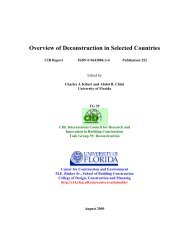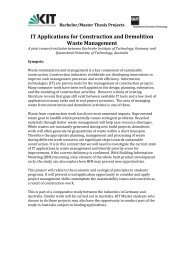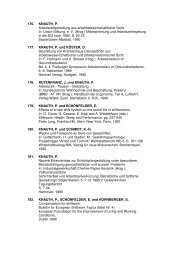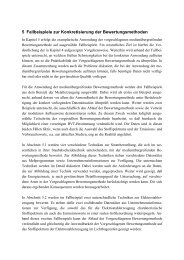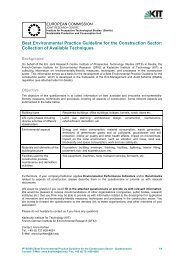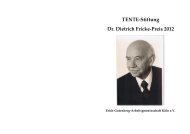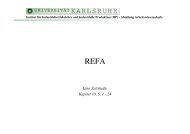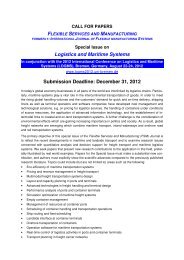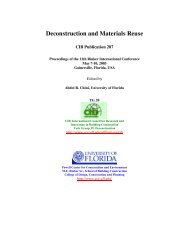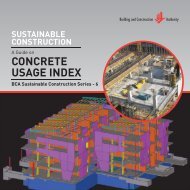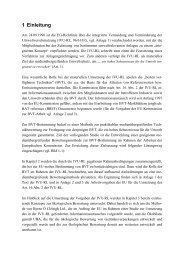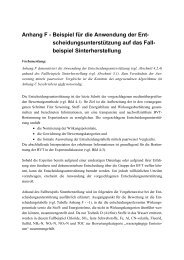Waste reduction final report -4 - Test Input
Waste reduction final report -4 - Test Input
Waste reduction final report -4 - Test Input
You also want an ePaper? Increase the reach of your titles
YUMPU automatically turns print PDFs into web optimized ePapers that Google loves.
Envest (GB), BECOSE (Finland), ECOSOFT (A), ESCALE (F), Sima-Pro (NL), LEGEP<br />
(DE).<br />
In Switzerland, a list of ecological indicators for various construction (and other) materials<br />
has been developed. Data are representing Swiss averages and are based mainly on the<br />
ecoinvent Database. This list is a basis for various Swiss building assessment tools such as<br />
the "electronic constructional element catalogue" or the Software "LTE Ogip" [Empa 2009].<br />
Recently KBOB, as coordination platform for governmental building owners, together with<br />
many private companies from the material and construction industry launched a project to<br />
expand and update life cycle inventory data for construction materials and products. Theses<br />
data should be part of the ecoinvent data base 3.0 that should be available by the end of 2011.<br />
A rough calculation of ecological impacts of specific components can be made with the help<br />
of a “checklist for components” (Bauteilkatalog). Calculations integrate production phase,<br />
renewal and deposition of the materials over a building lifetime of 100 years. Impacts are<br />
shown for environmental burdens, grey energy and greenhouse effect. You can find more<br />
details on www.bauteilkatalog.ch (d/f)<br />
4. Examples, case studies<br />
This chapter shows selected examples where construction resources use and waste are or<br />
have been significantly reduced or where there are made attempts aiming at this.<br />
MINERGIE-ECO ® - www.minergie.ch (d/f/i/e)<br />
MINERGIE® and MINERGIE-P® are labels for sustainable buildings. MINERGIE has been<br />
initiated in 1994 and today is the most important and widely accepted energy-standard for<br />
low-energy buildings in Switzerland. In 2006, the MINERGIE-ECO® standard has been<br />
added in cooperation with the Swiss association eco-bau. This standard does not only cover<br />
aspects of energy-efficiency and thermal comfort, but also health and building material<br />
aspects concerning the choice of construction materials and indoor environmental quality.<br />
In order to get a MINERGIE-ECO® or MINERGIE-P-ECO® certificate, a building needs to<br />
fulfil a catalogue of criteria on the basis of the MINERGIE®- or the MINERGIE-P®<br />
standard [CIB 2008]. Today, there are 14,217 buildings certified with the MINERGIE®<br />
standard, 481 with MINERGIE-P®, 54 with MINERGIE-ECO® and 61 with MINERGIE-P-<br />
ECO® - most of them in Switzerland, some in bordering countries (updates of these figures<br />
on the website). It can be claimed that at the moment MINERGIE-ECO® leads to the most<br />
sustainable way of building constructing in Switzerland. For example, the use of recycling<br />
concrete is mandatory and there is put focus on separable and locally produced materials.<br />
Taking into account the whole life cycle costing, buildings as to this label are cheaper in most<br />
of the cases. However, a building implementing all points demanded has higher costs of<br />
about 20% than a building considering basic regulations at the beginning of its life. This can<br />
be an obstacle to choose MINERGIE-ECO®.<br />
Initiatives on the internet<br />
There have been made several attempts to establish routes for construction waste handling on<br />
the internet. However, none of these was really successful. Reasons are amongst other<br />
different standards in the cantons or the difficulty of obtaining the attention of enough users.<br />
Today, there are for example two routes on the internet:<br />
110



